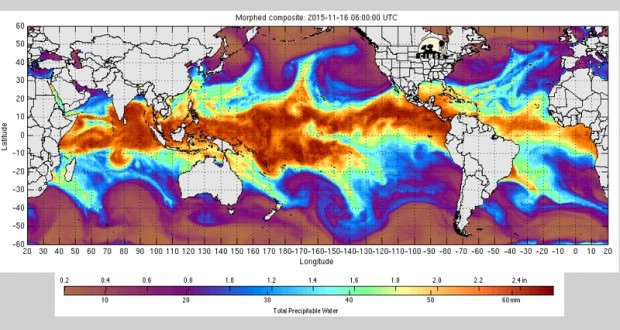COARSEGOLD – Though not every El Niño brings torrential rain and the resulting disasters, analysts believe with 95 percent certainty that this winter’s event will do just that, says John Kirk of the California Department of Water Resources.
Kirk addressed a standing-room-only crowd at the Clubhouse in Yosemite Lakes Park on Saturday, introducing them to new terms and concepts, such as ARkStorms and Atmospheric Rivers.
The larger the El Niño, the more significant the possibility of long thin bands of atmospheric moisture, called Atmospheric Rivers, said Kirk. Microwave images show these rivers streaming across the Pacific Ocean at 6,000 to 7,000 miles in length and a mile wide, carrying as much moisture as the Amazon River.
“This type of rainfall in the great storms of 1861-1862 brought sequoias as large as 30 feet in diameter down to the Valley floor,” said Kirk.
Taking lessons from the past, and working with recent advances in the understanding of California’s worst storms, the US Geological Survey (USGS) Multi-Hazards Demonstration Project has been working for years to develop a scientifically realistic scenario that has helped emergency planners prepare for the worst.
The ARkStorm (Atmospheric River 1,000 Storm) scenario has California experiencing 23 days of rain, causing massive flooding in the Sacramento and San Joaquin Valleys, with anticipated flooding of an area 20 miles wide, 300 miles long, and up to 18 feet deep in places. This would be the costliest disaster in the state’s history, and ten times worse than Hurricane Katrina because it would cover the entire state, said Kirk, who noted that this type of storm occurs every 100-200 years.
With huge areas of the state having been denuded by recent wildfires, the potential for flooding, debris flows, mudslides, and the release of contaminants is causing concern for emergency planers and government agencies across California.
Hydrologists have concluded that extreme winter storms will likely overwhelm flood protection systems, and that the massive tree mortality will exacerbate the situation as winds blow over dead trees blocking roadways, damaging power and sewer infrastructure, and damaging up to 25 percent of the homes in the state in a worst case scenario.
Repairs to water, power, sewer, and road lifelines would likely take months. There could also be storm-caused fires ignited by wind-downed power lines or ignition of petroleum products released into floodwaters. The economic costs of the storm are estimated to include $350 billion in physical damages and $58–$290 billion in business interruption losses.
With this year’s El Niño predicted to be significantly warmer and larger than 1997, the Yosemite Lakes Owners Association (YLOA) is getting well out ahead of any looming crises, starting with educating park residents at last Saturday’s meeting. They don’t intend to be caught unprepared, and the YLOA, in conjunction with the Yosemite Spring Park Utility Company (YSPUC) and Yosemite Lakes Community Church, have plans in place to deal with a worst case scenario.
Employees of the YLOA and the YSPUC have been cross-trained to deal with any anticipated emergencies, and will function as first responders until other agencies such as the Sheriff’s Office, CHP or Cal Fire take over an incident, said YLOA Head of Security Tammi d’Amore.
Plans for traffic control, designated evacuation routes and radio communication are already in place, and residents are urged to follow all verbal instructions from first responders in the event of any type of evacuation.
“Sometimes residents trying to help cause more hindrance than assistance,” says d’Amore, who said that once people have been asked to leave, then need to stay out of the area until told that it is safe to return.
YSPUC Manager Ken Harrington said his people are working to make sure culverts are clear for unobstructed water runoff, and that Madera County Fire Station 10 has been set up as a sandbag location.
Loss of power would knock out the ability to pump water and replenish YLP’s 3-million gallon storage capacity, and rationing may have to be implemented to manage that supply if necessary, said Harrington. YSPUC is reviewing the water system and possible generator support as they evaluate what would be needed for structure protection in the event of fire.
The Yosemite Lakes Community Church has been designated as a Red Cross location, providing food and shelter for displaced residents and small pets. YLCC Assistant Pastor Dean Dew encouraged everyone to be prepared, get to know their neighbors and work together.
The YLOA has compiled a list of resources and website links to assist everyone in preparing for this type of emergency. It is available on their website at http://yloa.org/safety/be-prepared.
A basic family emergency supply kit includes:
- Canned food for 3-5 days with a manual can opener
- Water to last 3-5 days, one gallon per person, per day
- Any medications needed, eyeglasses
- Battery-powered or hand crank radio and extra batteries
- Flashlight and extra batteries
- Wrench or pliers to turn off utilities
- Whistle to signal for help
- First Aid kit and first aid manual
- Dust mast to help filter contaminated air, plastic sheeting and duct tape to shelter in place
- Extra clothing
- Local maps
- Infant formula and diapers
- Important family documents in waterproof container
- Cash and credit cards
- Sleeping bags or blankets
- Family and pet emergency plan
To learn more about Atmospheric Rivers:
http://tropic.ssec.wisc.edu/real-time/mimic-tpw/global2/main.html
http://www.esrl.noaa.gov/psd/atmrivers
http://www.esrl.noaa.gov/psd/atmrivers/questions
http://www.scientificamerican.com/article/megastorms-could-down-massive-portions-of-california
http://www.nature.com/scientificamerican/journal/v308/n1/box/scientificamerican0113-64_BX1.html
http://meteora.ucsd.edu//~jnorris/weather_disc/AtmRivers.pdf
Historic Flooding in 1861:
http://cepsym.org/history/LakeSacramento_book.pdf
The ARkStorm:
http://pubs.usgs.gov/of/2010/1312




